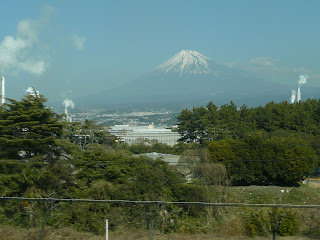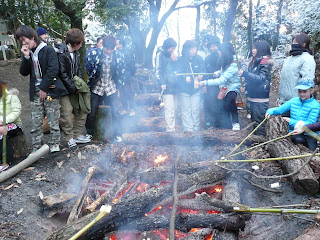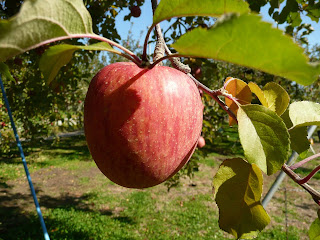But, this morning, with talk of a possible nuclear meltdown 450km away, we have trouble staying calm. The school where we work and learn has turned virtual. We are glued to the television whilst we study and prepare classes for the day. Military helicopters unsuccessfully dump water on the Fukushima nuclear plant, they cannot get too close as radiation levels at the plant are too high. A blue fire truck squirts a dribble of water within 2 metres of reactor three. He huffs and he puffs but he cannot reach the reactor, someone inside is risking his life being so close. Couldn't they see that it was too weak before they got so close? The little blue fire truck was sent to save Japan. It failed. The helicopters could not get any closer. The radiation levels are too high. Those brave Samurais are requested to risk their lives and save a nation. They are the heroes of Japan. They almost certainly will shorten or even lose their lives, this is the honourable thing to do.
This is Japan.
The earthquake wasn't too scary in Nagoya. Upstairs, on the first floor, we swayed more than usual and for much longer than expected. Having practised an earthquake drill only 3 days earlier, we dutifully complied with the normal , "Duck and Cover" routine, fresh in our memory. Sway, sway, creak, creak. Although some nervously laughed at the earthquake in Nagoya. I didn't think it was that much fun at all. I have felt a few minor tremors since coming to Japan, 11 months earlier, but none like this. This seemed wide ranging and extremely long lasting. I would guess, 10 minutes long? Trying to get back to work to meet a deadline, we again, felt the huge aftershock 30 minutes later. What's going on? Ten minutes later my brother sent me a text from Australia. Eh? We really need to get this work done by 5pm, but then a skype call. I'm fine, I'm fine, I write, yes, yes, we felt the quake. We are fine, don't worry! What's happened? Why is my family ringing me and how did they know about this so quickly?
We are oblivious to events unfolding north from here and we are really trying to finish our work before the weekend. On edge and excitable after the earthquake and aftershocks, we propose some unrealistic developments for the school.
We feel sick. After a late night at school, we arrive home to discover that a tsunami has severely impacted on the region of Sendai. The visual images are sent around the world. It is enormous, an absolute catastrophe, many 100s of people have been swept away with little warning. At 8.9 the earthquake was the largest ever recorded in Japan. Cars, boats, houses, buildings are swept inland and out, back and forth again, crashing and consuming everything in their path. A bling, bling sound and flashing lights alert us to the where abouts of the most recent aftershock We experience many aftershocks in Nagoya too. The third catastrophe brings more anguish for this nation, damage at the Fukushima nuclear power plant. Will this ever stop. The enormity of the situation is only now coming to light. Catastrophe after catastrophe are playing havoc on everyone in this nation. We are all on edge now. We receive a multitude of messages from our family and friends in Australia. All with the same message, come home. It is difficult to ignore. We cannot understand the full story, what is really happening at the Fukushima power plant? We hear of explosions, radiation leaking, improvement, more explosions. The government informs the people to stay united and to stay calm. We feel no sense of relief from the government. We do not feel calm. We struggle for information and projections. We are told to relax, that we will have hours or maybe days to get out if we need to. Hours to get out? Hardly a reassuring message. We are torn. The Japanese try to comfort us with stories of Hiroshima, people only 50km from the centre of the explosion were affected. We are too far away. The French are evacuated. We try to stay strong and calm like the Japanese. The Japanese government put a 20-30km exclusion zone on the area, the US government puts a 80km exclusion zone. Why the difference? We get mixed messages from day to day, hour to hour. We cannot make heads or tails of the truth. What can we do? Most Europeans are being pulled out from Japan. We are made an offer to temporarily evacuate. We wait. We do not want to leave this country. Our friends, students and school are the centre of our Japanese life. We do not want our year in Japan to end. We have loved every minute of being here. We have travelled every weekend, danced at Obon, tried every dish on offer and had a lifetime of hot thermal baths. We have religiously studied the Japanese language and embraced every possible Omatsuri that we can understand. We love Japan. We try to get accurate information but feel helpless about finding the truth. Enough is enough. Nuclear reactor 3 which contains plutonium is on fire. Attempts to cool it seem fruitless. Many of our friends and colleagues have gone. We do not see the point in needless risk. We reluctantly book the tickets.
Now, back in Australia, we are told that 10 000 people are confirmed dead. 18,000 people are missing. 250,000 people are homeless, many of them mourning the loss of their loved ones. People are traumatized and still worried about the risk from radiation. Others to the north still wait for basic supplies, food, water, kerosene heaters. What is their future? Back in our Nagoya neighbourhood of Higashiyama Koen, children have drawn SOS is in the playground. The stress on the children all over Japan must be extreme. Fukushima Nuclear power plant is still at risk and unstable. Radiation is found in the water at Tokyo, some vegetables and soil is contaminated. We still have mixed advice from differing governing bodies. Catastrophe after catastrophe after catastrophe. How can Japan ever recover from this? How can we help Japan? Perhaps the sakura, the Japanese cherry blossom, due any day now will help. Did 17th Century Japanese poet; Basho experience something similar? His haiku eloquently describes this situation. "Come see real flowers of this painful world." The delicate sakura will ease their pain, as another chapter in Japan's volatile history is being written. Hopefully this chapter will end soon.




















































